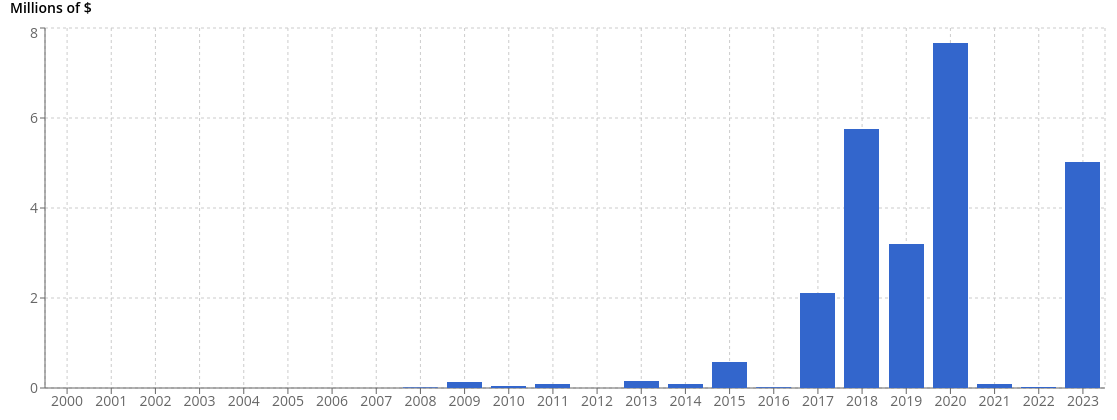Focus on Barkley L. Hendricks
[20 Jun 2023]The extraordinary breakthrough of Barkley L. HENDRICKS on the auction market is emblematic of the importance finally granted to the ‘black portrait’
Few collectors were chasing works by Barkley L. Hendricks ten years ago. Today, the artist is a must in the biggest American collections and auction sales. The recent and strong revaluation of his works has pushed the artist into the upper echelons of our global auction ranking by turnover; by mid-June this year, Hendricks’s turnover total gave him the 122nd place thanks to the sale of a single work – Stanley (1971) – a striking full-length portrait that fetched $6.1 million during the sale of the Gerald Fineberg Collection last May at Christie’s. Artprice by Artmarket takes a look back over the career and work of this immense African-American artist, pioneer of the new African-American portrait.
Born in Philadelphia in 1945, Barkley L. HENDRICKS studied at the city’s Academy of Fine Arts where he was the first black student to be awarded two prizes, one of which included a trip to the museums of Europe (United Kingdom, Spain, Italy and the Netherlands) from which he returned marked by the intensity of the historical portraits he discovered, notably those of Rembrandt, Diego Velázquez and Anthony van Dyck. He was also struck by the rarity of portraits of black people in museum collections. Back in the United States, he began to combine European artistic conventions with his own contemporary sensibility in his canvases.
Hendricks: Evolution of his annual auction turnover

Hendricks revolutionized the history of the portrait
The portrait – a genre that straddles a wide range of motives and raison d’êtres including testimony, vanity, humanity, convention and the search for truth – is a constant throughout the entire history of art. Historically, full-length portraits were reserved for kings, queens, nobles and important people, and traditionally such portraits had a ceremonial function celebrating men and women of power, often confirming their continuity by portraying their progeniture and wealth. The greatest artists have of course been able to divert the pretext of the official portrait to represent the souls and characters of their models, and it was precisely this task to which Hendricks applied himself. Upon returning from his cultural trip to Europe, he began to paint people who looked like him: young, hip and black. He painted them life-size on luminous neutral backgrounds that highlight their presence and make them real modern icons.
Painted mainly between the end of the 1960s and the beginning of the 1980s, his paintings and photographs of ordinary black Americans completely changed the way black people in America were depicted, both in terms of the artistic construction of his works and the sensitivity of his treatment of the subjects. Hendricks managed to capture the self-awareness, self-esteem and vulnerability of his friends and relations all at the same time. The intensity of his portraits set a precedent for many African-American artists, including Kerry James Marshall (b. 1955), Mickalene Thomas (b. 1971), Amy Sherald (b. 1973) and Kehinde WILEY (b. 1977).
Any consideration of my work has to take into mind the work of Barkley Hendricks. He is completely foundational to my understanding of how you can make painting relevant today.”
— Kehinde Wiley
Growing notoriety and rising prices
When Hendricks began working with New York gallery Jack Shainman in 2005, his works were still unknown to the vast majority of American collectors and they had never appeared at auction. It was not until 2008 when Trevor Schoonmaker at the Nasher Museum of Art organized a now famous traveling retrospective titled “Barkley L. Hendricks: Birth of the Cool” that Hendricks acquired a certain international notoriety and his works began to appear on the auction market. The first works presented were not his best or the most representative of his work and his market didn’t take off until the following year (2009) when Swann auction house offered a large full-length portrait of the determined-looking Angie (1973) which fetched an encouraging first result of $144,000. In 2015, the same auction house sold his Steve (1976) portrait for $365,000, double its estimate; but it was the year of his death (in 2017) that saw bidding move into a new scale. Sotheby’s sold two works at more than $940,000 each in May, a sign that the market was ready to offer the artist his first 7-digit result. And indeed, that came on 17 May 2018 when Sotheby’s sold his sublime silhouette of a Dancer for $2 million against an estimate of $400,000 – 600,000. With his latest auction record at $5 million this year, Hendricks’ market is still climbing at a rapid pace and it will be interesting to see if his prices reach those achieved by Kerry James MARSHALL, three of whose works have already fetched over $10 million each.

Upcoming exhibition:
Barkley L. Hendricks: Portraits at the Frick – 21 September 2023 – 7 January 2024




 0
0
